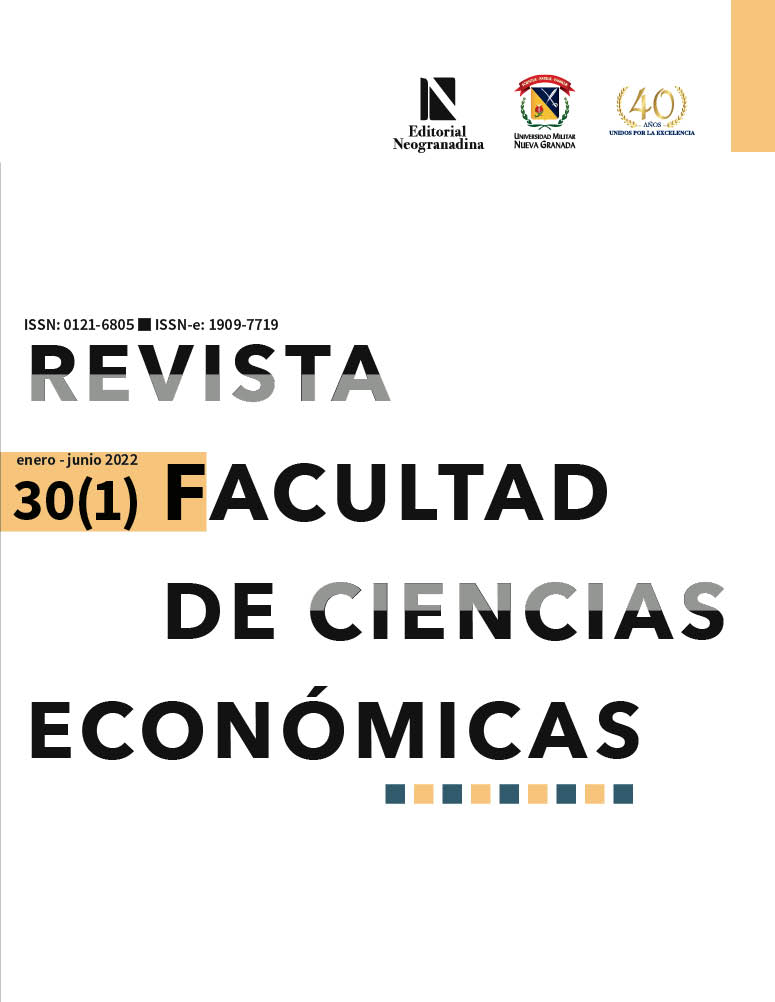Redes de colaboração empresarial para PMEs
uma revisão do estado da arte
Resumo
Segundo dados da Câmara de Comércio de Bogotá, a partir de 2019 houve um aumento no número de empresas que cancelaram suas operações. Apesar de uma ligeira recuperação no início de 2020, a crise económica e social desencadeada pela pandemia de COVID-19 (SARS-CoV-2) tem sido implacável junto do empresariado local e afetou principalmente o setor das PME. As taxas de desemprego distrital atingiram 16,3% no final de 2020 e a contração do PIB local aproximou-se de 6,4%. Como alternativa para aumentar a competitividade e inovação nas PMEs, bem como uma opção para sua sobrevivência em tempos de crise, a estratégia de plataforma colaborativa vem sendo trabalhada e implementada nas últimas duas décadas em todo o mundo. O conceito de colaboração empresarial está associado à resiliência económica das organizações humanas ao propor práticas inovadoras e mobilizar recursos em resposta às dificuldades e desafios existentes. Nesse sentido, o objetivo deste artigo é revisar o estado da arte das redes de colaboração empresarial, expondo suas principais características, as fases de sua implementação, sua formulação, métodos de análise e aplicações práticas, com a finalidade de expor a conveniência, alcance e possíveis limitações desta estratégia como uma opção para as PMEs locais para mitigar o seu crescente encerramento com os impactos económicos e sociais que isso implica.
Downloads
Referências
Agostini, L. y Nosella, A. (2018). Inter-organizational Relationships Involving SMEs: A Bibliographic Investigation into the State of the Art. Long Range Planning, 52(1), 1-31.
Ahn, J. M., Kim, D. y Moon, S. (2017). Determinants of Innovation Collaboration Selection: A Comparative Analysis of Korea and Germany. Innovation, 19(2), 125-145. DOI: https://doi.org/10.1080/14479338.2016.1241152
Alfaro, J., Rodríguez, R. y Ortiz, A. (2005). A Performance Measurement System for Virtual and Extended Enterprises. Proceedings of PRO-VE’05 – Collaborative Networks and their Breeding Environments. Springer.
Antonelli, D. y Taurino, T. (2009). Analysis of Potential Collaborations in SMEs Networks. IFAC Proceedings Volumes, 42(4), 2059-2064. DOI: https://doi.org/10.3182/20090603-3-RU-2001.0555
Antonelli, D. y Taurino, T. (2011). Identifying and Exploiting the Collaboration Factors inside SMEs Networks. International Journal of Networking and Virtual Organisations, 9(4), 382. DOI: https://doi.org/10.1504/IJNVO.2011.043805
Antonelli, D., Bruno, G., Taurino, T. y Villa, A. (2013). Conditions for Effective Collaboration in SMEs Networks Based on Graph Model. En L. M. Camarinha-Matos y R. J. Scherer (Eds.), Collaborative Systems for Reindustrialization (pp. 129-136). Springer. DOI: https://doi.org/10.1007/978-3-642-40543-3_14
Aragón-Correa, J. A., y Sharma, S. (2003). A Contingent Resource-Based View of Proactive Corporate Environmental Strategy. Academy of Management Review, 28(1), 71-88. DOI: https://doi.org/10.5465/amr.2003.8925233
Arras Vota, A. M., Fierro Murga, L. E., Jaquez Balderrama, J. L. y López Díaz, J. C. (2010). Redes de colaboración. Estrategia empresarial en la inserción a cadenas de valor. Revista Mexicana de Agronegocios, 26, 1-11.
Arras Vota, A. M., Hernández Rodríguez, O. y López Díaz, J. C. (2012). Redes y confianza: dimensiones del capital social en las microempresas rurales en Chihuahua, México. Nueva antropología, 25(77), 31-57.
Assoretipmi, 2021: www.retipmi.it.
Villa, A. (Ed.), Managing Cooperation in Supply Network Structures and Small or Medium-sized Enterprises: Main criteria and tools for managers. Springer-Verlag. ISBN/ISSN: 978085729|21, 2011. DOI: https://doi.org/10.1007/978-0-85729-363-3
Baker, G., Gibbons, R. y Murphy, K. J. (2002). Relational Contracts and the Theory of the Firm. The Quarterly Journal of Economics, 117(1), 39-84. DOI: https://doi.org/10.1162/003355302753399445
Barney, J. (1991). Firm Resources and Sustained Competitive Advantage. Journal of Management, 17(1), 99-120. DOI: https://doi.org/10.1177/014920639101700108
Battisti, M., y Deakins, D. (2017). The Relationship Between Dynamic Capabilities, the firm’s Resource Base and Performance in a Post-Disaster Environment. International Small Business Journal, 35(1), 78-98. DOI: https://doi.org/10.1177/0266242615611471
Baum, H. (2011). Morphologie der Kooperation als Grundlage für das Konzept der Zwei-Ebenen-Kooperation. Gabler Verlag. DOI: https://doi.org/10.1007/978-3-8349-6197-6
Baum, H. y Schütze, J. (2013). An Organizational Concept for Collaborative Enterprise Networks. Procedia CIRP, 7, 55-60. DOI: https://doi.org/10.1016/j.procir.2013.05.010
Baum, J. A. C., Cowan, R. y Jonard, N. (2010). Network-Independent Partner Selection and the Evolution of Innovation Networks. Management Science, 56(11), 2094-2110. DOI: https://doi.org/10.1287/mnsc.1100.1229
Becerra Rodríguez, F., Serna Gómez, H. M. y Naranjo Valencia, J. C. (2013). Redes empresariales locales, investigación y desarrollo e innovación en la empresa. Cluster de herramientas de Caldas, Colombia. Estudios Gerenciales, 29(127), 247-257. DOI: https://doi.org/10.1016/j.estger.2013.05.013
Becerra R., F. y Naranjo V., J. C. (2008). La innovación tecnológica en el contexto de los clusters regionales. Cuadernos de Administración, 21(37), 133-159.
Bogataj, M., Grubbström, R. W. y Bogataj, L. (2011). Efficient location of industrial activity cells in a global supply chain. International Journal of Production Economics, 133(1), 243-250. DOI: https://doi.org/10.1016/j.ijpe.2010.09.035
Bougrain, F. y Haudeville, B. (2002). Innovation, collaboration and SMEs internal research capacities. Research Policy, 31(5), 735-747. DOI: https://doi.org/10.1016/S0048-7333(01)00144-5
Briones, A. J., Laborda, F. y López, C. (2007). Visión estratégica y praxis de la cooperación empresarial. Revista Del Foro Iberoamericano Sobre Estrategias De Comunicación (Fisec). III(6), 86-107.
Cámara de Comercio de Bogotá. (2021). En Cámara de Comercio de Bogotá. https://www.ccb.org.co
Camarinha-Matos, L. M. y Afsarmanesh, H. (2006). Collaborative Networks. En K. Wang, G. L. Kovacs, M. Wozny y M. Fang (Eds.). Knowledge Enterprise: Intelligent Strategies in Product Design, Manufacturing, and Management, 207, 26-40. Springer. DOI: https://doi.org/10.1007/0-387-34403-9_4
Camarinha-Matos, L. M. y Scherer, R. J. (Eds.). (2013). Collaborative Systems for Reindustrialization: 14th IFIP WG 5.5 Working Conference on Virtual Enterprises, PRO-VE 2013, Dresden, Germany, September 30-October 2, 2013, Proceedings 408. Springer Berlin Heidelberg. DOI: https://doi.org/10.1007/978-3-642-40543-3
Camarinha-Matos, L. M. y Abreu, A. (s. f.). Performance Indicators Based on Collaboration Benefits. IFIP, The International Federation for Information Processing, 273-282
Cepal. (2017, 15 de febrero). Acerca de microempresas y pymes. https://www.cepal.org/es/temas/pymes/acerca-microempresas-pymes
Chatterjee, S., Chaudhuri, R., Vrontis, D. y Piccolo, R. (2021). Enterprise Social Network for Knowledge Sharing in MNCs: Examining the Role Of Knowledge Contributors and Knowledge Seekers for Cross-Country Collaboration. Journal of International Management, 27(1), 100827. DOI: https://doi.org/10.1016/j.intman.2021.100827
Chen, H. L., Hsu, W. T. y Chang, C. Y. (2014). Family Ownership, Institutional Ownership, and Internationalization of SMEs. Journal of Small Business Management, 52(4), 771-789. DOI: https://doi.org/10.1111/jsbm.12031
Choi, T. Y., Dooley, K. J. y Rungtusanatham, M. (2001). Supply Networks and Complex Adaptative Systems: Control Versus Emergence. Journal of Operations Management, 19(3), 351-366. https://doi.org/10.1016/S0272-6963(00)00068-1
Compra lo nuestro. (2021). En compra lo nuestro. https://compralonuestro.co
Departamento Administrativo Nacional de Estadística. (2021) En DANE. https://www.dane.gov.co/
Dyer, J. H., Singh, H. y Hesterly, W. S. (2018). The Relational View Revisited: A Dynamic Perspective on Value Creation and Value Capture. Strategic Management Journal, 39(12), 3140-3162. DOI: https://doi.org/10.1002/smj.2785
Ebersberger, B. y Herstad, S. J. (2011). Product Innovation and the Complementarities of External Interfaces. European Management Review, 8(3), 117-135. DOI: https://doi.org/10.1111/j.1740-4762.2011.01014.x
Eisenhardt, K. M. y Schoonhoven, C. B. (1996). Resource-based View of Strategic Alliance Formation: Strategic and Social Effects in Entrepreneurial Firms. Organization Science, 7(2), 136-150. DOI: https://doi.org/10.1287/orsc.7.2.136
European Commission. (2014). For a European Industrial Renaissance. European Union.
European Union. (2012). European Competitiveness Report 2012. Reaping the benefits of globalization. Commission Staff Working Document.
SWD (2012). Accompanying document to the Communication from the Commission. A stronger European Industry for Growth and Economic Recovery Industrial Policy Communication Update COM(2012)582 final. http://ec.europa.eu/enterprise/policies/industrial-competitiveness/competitiveness-analysis/european-competitiveness-report/files/ecr2012_full_en.pdf, retrieved on April 2013
French Ministry for the Economy and Finance (Minefi) (2011). Competitiveness Clusters in France. http://competitivite.gouv.fr/documents/commun/Documentation_poles/brochures_poles/anglais/brochure-ang-internet.pdf.
Gabriunas, I. P. (2012). Capital humano, redes externas e innovación en la industria colombiana. Estudios Gerenciales, 81-107. DOI: https://doi.org/10.18046/j.estger.2012.1480
García Martínez, M., Zouaghi, F., García Marco, T. y Robinson, C. (2019). What Drives Business Failure? Exploring the Role of Internal and External Knowledge Capabilities during the Global Financial Crisis. Journal of Business Research, 98, 441-449. DOI: https://doi.org/10.1016/j.jbusres.2018.07.032
German Federal Ministry for Economic Affairs and Energy (BMWi). (2018). Clusterplattform Deutschland - Allgemeine Clustersuche. https://www.clusterplattform.de/SiteGlobals/CLUSTER/Forms/Suche/DE/Clustersuche_Formular. html
Gertsen, M. C., y Søderberg, A.-M. (2011). Intercultural Collaboration Stories: On Narrative Inquiry and Analysis as Tools for Research in International Business. Journal of International Business Studies, 42(6), 787-804. DOI: https://doi.org/10.1057/jibs.2011.15
González, T. E. y Martín, V. M. A. (2018). Redes de cooperación empresarial internacionales en el sector ambiental y cooperación triangular. Universidad & Empresa, 20(35), 51-77. DOI: https://doi.org/10.12804/revistas.urosario.edu.co/empresa/a.5307
Gupta, H. y Barua, M. K. (2016). Identifying Enablers of Technological Innovation for Indian MSMEs using Best–Worst Multi Criteria Decision Making Method. Technological Forecasting and Social Change, 107, 69-79. DOI: https://doi.org/10.1016/j.techfore.2016.03.028
Heide, J. B. y Miner, A. S. (1992). The Shadow of the Future: Effects of Anticipated Interaction and Frequency of Contact on Buyer-Seller Cooperation. Academy of Management Journal, 35(2), 265-291. DOI: https://doi.org/10.2307/256374
Hessels, J. y Parker, S. C. (2013). Constraints, Internationalization and Growth: A Cross-country Analysis of European SMEs. Journal of World Business, 48(1), 137-148. DOI: https://doi.org/10.1016/j.jwb.2012.06.014
Johanson, J. y Vahlne, J.-E. (2009). The Uppsala Internationalization Process Model Revisited: From Liability of Foreignness to Liability of Outsidership. Journal of International Business Studies, 40(9), 1411-1431. DOI: https://doi.org/10.1057/jibs.2009.24
Kaats, E. y Opheij, W. (2013). Creating Conditions for Promising Collaboration: Alliances, Networks, Chains, Strategic Partnerships. Springer Science & Business Media. DOI: https://doi.org/10.1007/978-3-642-41443-5
Kang, K.-N. y Park, H. (2012). Influence of Government R&D Support and Inter-firm Collaborations on Innovation in Korean Biotechnology SMEs. Technovation, 32(1), 68-78. DOI: https://doi.org/10.1016/j.technovation.2011.08.004
Khurana, S., Haleem, A., Luthra, S., y Mannan, B. (2021). Evaluating Critical Factors to Implement Sustainable Oriented Innovation Practices: An Analysis of Micro, Small, and Medium Manufacturing Enterprises. Journal of Cleaner Production, 285, 125-377. DOI: https://doi.org/10.1016/j.jclepro.2020.125377
Kim, H. y Park, Y. (2010). The Effects of Open Innovation Activity on Performance of SMEs: The Case of Korea. International Journal of Technology Management, 52(3/4), 236. DOI: https://doi.org/10.1504/IJTM.2010.035975
Konsti-Laakso, S., Pihkala, T. y Kraus, S. (2012). Facilitating SME Innovation Capability Through Business Networking. Creativity and Innovation Management, 21(1), 93-105. DOI: https://doi.org/10.1111/j.1467-8691.2011.00623.x
Lasagni, A. (2012). How Can External Relationships Enhance Innovation in SMEs? New Evidence for Europe. Journal of Small Business Management, 50(2), 310-339. DOI: https://doi.org/10.1111/j.1540-627X.2012.00355.x
Laskovaia, A., Marino, L., Shirokova, G. y Wales, W. (2019). Expect the Unexpected: Examining the Shaping Role of Entrepreneurial Orientation on Causal and Effectual Decision-Making Logic during Economic Crisis. Entrepreneurship & Regional Development, 31(5/6), 456-475. DOI: https://doi.org/10.1080/08985626.2018.1541593
Lei, D., Slocum, J. W. y Pitts, R. A. (1997). Building Cooperative Advantage: Managing Strategic Alliances to Promote Organizational Learning. Journal of World Business, 32(3), 203-223. DOI: https://doi.org/10.1016/S1090-9516(97)90008-0
Macneil, I. R. (1980). The New Social Contract: An Inquiry into Modern Contractual Relations. DOI: https://doi.org/10.2307/1288310
Manrique, O. L. (2006). Fuentes de las economías de aglomeración: una revisión bibliográfica. Cuadernos de Economía, 25(45), 53-73. https://revistas.unal.edu.co/index.php/ceconomia/article/view/548
Marshall, A. (1988). Principles of Economics: An Introductory Volume. http://link.springer.com/book/10.1057/9781137375261
Martín del Peso, M. (2004). Los consorcios monosectoriales de promoción en el proceso de internacionalización de la empresa: factores de éxito de la cooperación. Biblioteca Virtual Miguel de Cervantes. http://www.cervantesvirtual.com/nd/ark:/59851/bmc611b1
Mei, L., Zhang, T. y Chen, J. (2019). Exploring the Effects of Inter-Firm Linkages on SMEs’ Open Innovation from an Ecosystem Perspective: An Empirical Study of Chinese Manufacturing SMEs. Technological Forecasting and Social Change, 144, 118-128. DOI: https://doi.org/10.1016/j.techfore.2019.04.010
Méndez, R. (2015). Redes de colaboración y economía alternativa para la resiliencia urbana: Una agenda de investigación. Biblio3W. Revista Bibliográfica de Geografía y Ciencias Sociales, XX (1.139), 2-24.
Michaelides, R., Morton, S. C., Michaelides, Z., Lyons, A. C. y Liu, W. (2013). Collaboration Networks and Collaboration Tools: A Match for SMEs? International Journal of Production Research, 51(7), 2034-2048. DOI: https://doi.org/10.1080/00207543.2012.701778
Michalus, J. C., Hernández, L. A., Hernández, G. D., Suárez, J. y Sarache4, W. A. (2011). Modelo cooperativo de microempresas, pequeñas y medianas empresas orientado al desarrollo agrario local. Pastos y forrajes, 34(2), 219-234.
Ministerio de Trabajo (2019). “Mipymes representan más de 90 % del sector productivo nacional y generan el 80 % del empleo en Colombia”, ministra Alicia Arango. https://www.mintrabajo.gov.co/prensa/comunicados/2019/septiembre/mipymes-representan-mas-de-90-del-sector-productivo-nacional-y-generan-el-80-del-empleo-en-colombia-ministra-alicia-arango
Mipymes. (2021). En Mipymes. http://www.mipymes.gov.co
Miranda, F. (2021). La reactivación en Bogotá. https://www.portafolio.co/opinion/francisco-miranda-hamburger/la-reactivacion-en-bogota-548390
Monroy, F. D. L. (2010). La asociatividad como modelo de gestión para promover las exportaciones en las pequeñas y medianas empresas en Colombia. Revista de Relaciones Internacionales, Estrategia y Seguridad, 5(2), 161-191. DOI: https://doi.org/10.18359/ries.126
Montoya R., L. A., Montoya R., I. A., Castellanos D., O. F. (2008). De la noción de competitividad a las ventajas de la integración empresarial. Revista Facultad de Ciencias Económicas: Investigación y Reflexión, 16(1), 59-70.
Mühlbacher, H. y Böbel, I. (2019). From Zero-Sum to Win-Win. Organizational Conditions for Successful Shared Value Strategy Implementation. European Management Journal, 37(3), 313-324. DOI: https://doi.org/10.1016/j.emj.2018.10.007
Münch, T., Buchmann, R., Pfeffer, J., Ortiz, P., Christl, C., Hladik, J., Ziegler, J., Lazaro, O., Karagiannis, D. y Urbas, L. (2013). An Innovative Virtual Enterprise Approach to Agile Micro and SME-Based Collaboration Networks. En L. M. Camarinha-Matos y R. J. Scherer (Eds.). Collaborative Systems for Reindustrialization (pp. 121-128). Springer. DOI: https://doi.org/10.1007/978-3-642-40543-3_13
Negrușa, A. L., Petrescu, D. C., Gică, O. A., Bota, M. y Rus, R. V. (2013). Perspectives on Clusters, Innovation and Best Practices in Life Science. Risoprint.
Ngasri, N. E. M. y Freeman, S. (2018). Conceptualizing Network Configurations as Dynamic Capabilities for Emerging Market Born Globals. International Studies of Management & Organization, 48(2), 221-237. DOI: https://doi.org/10.1080/00208825.2018.1443742
OECD. (2004). Promoting Entrepreneurship and Innovative SMEs in a Global Economy. OECD Publishing.
OECD. (2013). Small and medium enterprises. www.oecd.org/industry/smes/.
Ojala, A. y Tyrväinen, P. (2009). Impact of Psychic Distance to the Internationalization Behavior of Knowledge‐Intensive SMEs. European Business Review, 21(3), 263-277. DOI: https://doi.org/10.1108/09555340910956649
Ojeda, J. (2009). La cooperación empresarial como estrategia de las pymes del sector ambiental. Estudios Gerenciales, 25(110), 39-61. DOI: https://doi.org/10.1016/S0123-5923(09)70061-0
Payan, J. M. (2007). A Review and Delineation of Cooperation and Coordination in Marketing Channels. European Business Review, 19(3), 216-233. DOI: https://doi.org/10.1108/09555340710746473
Peng, C. y Meng, Y. (2016). Empirical Study of Manufacturing Enterprise Collaboration Network: Formation and Characteristics. Robotics and Computer-Integrated Manufacturing, 42, 49-62. DOI: https://doi.org/10.1016/j.rcim.2016.05.005
Petrescu, D. C., Rus, R. V. y Negruşa, A. L. (2014). Attitude of Companies: Network Collaboration vs. Competition. Procedia - Social and Behavioral Sciences, 148, 596-603. DOI: https://doi.org/10.1016/j.sbspro.2014.07.085
Pinto, P. E., Vallone, A., y Honores, G. (2019). The Structure of Collaboration Networks: Findings from three Decades of Co-Invention Patents in Chile. Journal of Informetrics, 13(4). https://ideas.repec.org/a/eee/infome/v13y2019i4s1751157719302202.html
Pittaway, L., Robertson, M., Munir, K., Denyer, D. y Neely, A. (2004). Networking and Innovation: A Systematic Review of the Evidence. International Journal of Management Reviews, 5, 137-168. DOI: https://doi.org/10.1111/j.1460-8545.2004.00101.x
PME. (2015). Rapport Annuel sur l’Evolution des PME, DGE – Direction Générale des Enterprises of the Ministère de L’Economie e des Finance. /www.economie.gouv.fr/cedef/chiffres-cles-des-pme
Saastamoinen, J., Reijonen, H. y Tammi, T. (2018). Should SMEs Pursue Public Procurement to Improve Innovative Performance? Technovation, 69, 2-14. https://doi.org/10.1016/j.technovation.2017.10.003
Schilke, O. y Cook, K. S. (2015). Sources of Alliance Partner Trustworthiness: Integrating Calculative and Relational Perspectives. Strategic Management Journal, 36(2), 276-297. DOI: https://doi.org/10.1002/smj.2208
Schoemaker, P. J. H., Heaton, S. y Teece, D. (2018). Innovation, Dynamic Capabilities, and Leadership. California Management Review, 61(1), 15-42. DOI: https://doi.org/10.1177/0008125618790246
Street, C. T. y Cameron, A.-F. (2007). External Relationships and the Small Business: A Review of Small Business Alliance and Network Research*. Journal of Small Business Management, 45(2), 239-266. DOI: https://doi.org/10.1111/j.1540-627X.2007.00211.x
Sun, J., Zou, H. y Xu, J. (2020). Game Analysis of Dual Network Embedded Enterprise Technology Innovation: Intelligent Manufacturing Pilot Perspective. Microprocessors and Microsystems, 103399. DOI: https://doi.org/10.1016/j.micpro.2020.103399
Sunley, P. (2008). Relational Economic Geography: A Partial Understanding or a New Paradigm? Economic Geography, 84(1), 1-26. DOI: https://doi.org/10.1111/j.1944-8287.2008.tb00389.x
TCI. (2017). Cluster Initiative Database. http://www.tci-network.org/initiatives.
Teece, D. J. (2007). Explicating dynamic capabilities: The Nature and Microfoundations of (Sustainable) Enterprise Performance. Strategic Management Journal, 28(13), 1319-1350. DOI: https://doi.org/10.1002/smj.640
Tolstoy, D. y Agndal, H. (2010). Network Resource Combinations in the International Venturing of Small Biotech Firms. Technovation, 30(1), 24-36. DOI: https://doi.org/10.1016/j.technovation.2009.06.004
Tranfield, D., Denyer, D. y Smart, P. (2003). Towards a Methodology for Developing Evidence-Informed Management Knowledge by Means of Systematic Review. British Journal of Management, 14(3), 207-222. https://doi.org/10.1111/1467-8551.00375
Valentijn, P. P., Vrijhoef, H. J. M., Ruwaard, D., de Bont, A., Arends, R. Y. y Bruijnzeels, M. A. (2015). Exploring the Success of an Integrated Primary Care Partnership: A Longitudinal Study of Collaboration Processes. BMC Health Services Research, 15, 32. DOI: https://doi.org/10.1186/s12913-014-0634-x
Van Gils, A. y Zwart, P. S. (2009). Alliance Formation Motives in SMEs: An Explorative Conjoint Analysis Study. International Small Business Journal, 27(1), 5-37. DOI: https://doi.org/10.1177/0266242608098345
Villa, A., Taurino, T. (2017). From SMEs Networks Towards Collaborative Management. Procedia Manufacturing, 13, 1297-1304. DOI: https://doi.org/10.1016/j.promfg.2017.09.060
Vrontis, D., Basile, G., Simona Andreano, M., Mazzitelli, A. y Papasolomou, I. (2020). The Profile of Innovation Driven Italian SMEs and the Relationship Between the Firms’ Networking Abilities and Dynamic Capabilities. Journal of Business Research, 114, 313-324. DOI: https://doi.org/10.1016/j.jbusres.2020.04.009
Vrontis, D. y Christofi, M. (2021). R&D Internationalization and Innovation: A Systematic Review, Integrative Framework and Future Research Directions. Journal of Business Research, 128, 812-823. DOI: https://doi.org/10.1016/j.jbusres.2019.03.031
Wältermann, M., Wolff, G. y Rank, O. (2019). Formal and Informal Cross-Cluster Networks and the role of Funding: A Multi-Level Network Analysis of the Collaboration among Publicly and Privately Funded Cluster Organizations and their Managers. Social Networks, 58, 116-127. DOI: https://doi.org/10.1016/j.socnet.2019.03.003
Wang, M., Mühlbacher, H., Wittmann, X. y Perrett, P. (2021). Dynamic Collaboration Between small and Medium-Sized Enterprises from Highly Dissimilar Markets. European Management Journal, 39(2), 185-200. DOI: https://doi.org/10.1016/j.emj.2020.06.004
Weaven, S., Quach, S., Thaichon, P., Frazer, L., Billot, K. y Grace, D. (2021). Surviving an Economic Downturn: Dynamic Capabilities of SMEs. Journal of Business Research, 128, 109-123. DOI: https://doi.org/10.1016/j.jbusres.2021.02.009
Williamson, O. E. (1979). Transaction-Cost Economics: The Governance of Contractual Relations. The Journal of Law and Economics, 22(2), 233-261. DOI: https://doi.org/10.1086/466942
Wycisk, C., McKelvey, B. y Hülsmann, M. (2008). “Smart parts” Supply Networks as Complex Adaptive Systems: Analysis and Implications. International Journal of Physical Distribution & Logistics Management, 38(2), 108-125. DOI: https://doi.org/10.1108/09600030810861198
Xu, Z., Lin, J. yLin, D. (2008). Networking and Innovation in SMEs: Evidence from Guangdong Province, China. Journal of Small Business and Enterprise Development, 15(4), 788-801. DOI: https://doi.org/10.1108/14626000810917861
Zadek, S. (2008). Global Collaborative Governance: There is no Alternative. Corporate Governance: The international journal of business in society, 8(4), 374-388. DOI: https://doi.org/10.1108/14720700810899121
Zahoor, N. y Al-Tabbaa, O. (2020). Inter-organizational Collaboration and SMEs’ Innovation: A Systematic Review and Future Research Directions. Scandinavian Journal of Management, 36(2), 101109. DOI: https://doi.org/10.1016/j.scaman.2020.101109
Zouaghi, F., Sánchez, M. y Martínez, M. G. (2018). Did the Global Financial Crisis Impact Firms’ Innovation Performance? The Role of Internal and External Knowledge Capabilities in High and Low Tech Industries. Technological Forecasting and Social Change, 132, 92-104. DOI: https://doi.org/10.1016/j.techfore.2018.01.011
Copyright (c) 2022 Revista Facultad de Ciencias Económicas

Este trabalho está licenciado sob uma licença Creative Commons Attribution-NonCommercial-NoDerivatives 4.0 International License.











